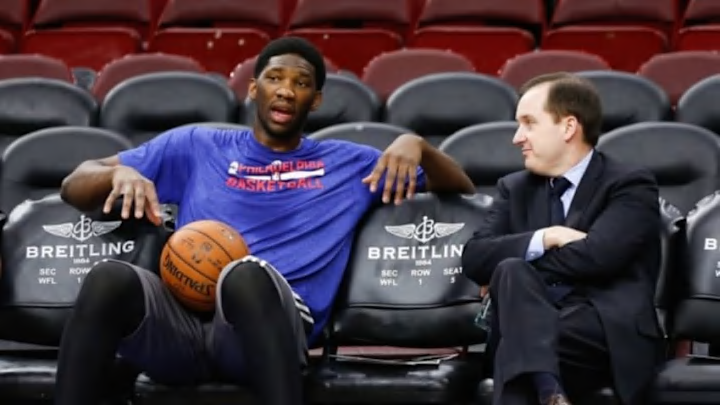
The rebuild of the Philadelphia 76ers and Sam Hinkie’s is an extreme outlier, having left the pack of conventional wisdom a long, long time ago. As Hinkie selected Jahlil Okafor in this year’s draft, a center for third straight season, it was just a dramatic restating of how little regard they hold for the traditional model of roster construction. Since Hinkie took over as General Manager, the 76ers roster has been a fluid and ever-changing experiment. It is not without purpose–they are building a stylistic identity and auditioning a huge pool of talent in the search for long-term contributors. But it is not a strategy that creates personnel stability.
Basketball-Reference, in their enormous database, now tracks roster continuity, defined as the percentage of a team’s minutes that were played by players who were also on the team the season before. These numbers are a perfect illustration of the effect the 76ers’ new regime has had on personnel stability. The graph below shows the year-by-year progression of roster continuity for each team over the last decade.

In terms of roster stability, the 76ers have fallen off a cliff. Through the first eight years of the last decade, they had an average year-to-year roster continuity of 77 percent. Over that time span, that number was the fourth highest in the league, trailing only the San Antonio Spurs, Oklahoma City Thunder/Seattle Supersonics and the Los Angeles Lakers. .
In the last two seasons the 76ers have had a roster continuity of 37 percent and then 29 percent, respectively. Those are not the two lowest numbers the league has seen but they are certainly outside the norm. In fact, they rank as the 17th and 33rd lowest roster continuity marks of the Three-Point Era (back to the 1979-80 season).

While they are not the lowest, the two most recent 76ers’ seasons are the only two on the table that occur consecutively. Teams rarely shake things up as dramatically as Philadelphia has for more than one season. If we broaden our scope and look at the lowest roster continuity marks across a two-season span, the 76ers move up quite a few notches

The 76ers are certainly an outlier, but they are not unique, even in within the last 15 years. The most troubling aspect of the Philadelphia’s rebuild, at least to outsiders, is there does not appear to be an obvious end in sight. In the best-case scenario for the 76ers, both Joel Embiid and Jahlil Okafor would play big minutes this year. That is to go along with the usual rotating cast of second round draft picks and D-League call ups. If we look at a three-season span of roster continuity, just one team in the Three-Point Era–the Hawks from 2003-06 have had a number below 40 percent. For the 76ers to get above that mark, they would need to have more than 54 percent of their minutes this season played by returning players. Although this is not necessarily the goal, they’d also have to win 31 games this year to best the Hawks win-loss record during that span.
Both of those numbers–31 wins and 54 percent roster continuity–seem unlikely this season given the way things are heading for Philadelphia so far this summer. If they miss both, their outlier status would be cemented and we’d have some dramatic new numeric evidence to pin on what has been, subjectively, one of the strangest exercises in team-building the NBA has ever seen.
